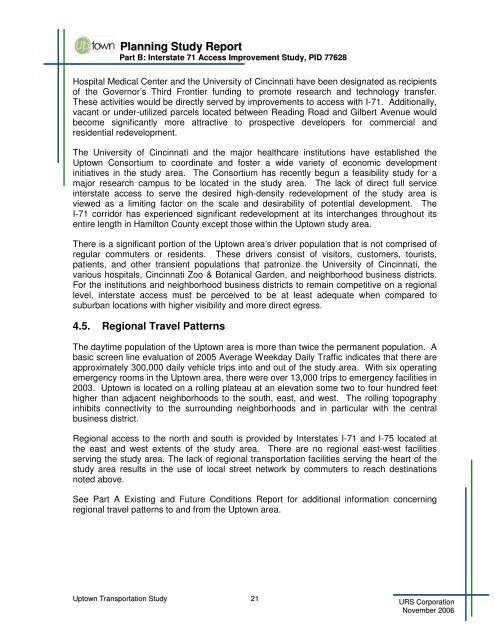Uptown Transportation Study - OKI
Uptown Transportation Study - OKI
Uptown Transportation Study - OKI
You also want an ePaper? Increase the reach of your titles
YUMPU automatically turns print PDFs into web optimized ePapers that Google loves.
Planning <strong>Study</strong> ReportPart B: Interstate 71 Access Improvement <strong>Study</strong>, PID 77628Hospital Medical Center and the University of Cincinnati have been designated as recipientsof the Governor’s Third Frontier funding to promote research and technology transfer.These activities would be directly served by improvements to access with I-71. Additionally,vacant or under-utilized parcels located between Reading Road and Gilbert Avenue wouldbecome significantly more attractive to prospective developers for commercial andresidential redevelopment.The University of Cincinnati and the major healthcare institutions have established the<strong>Uptown</strong> Consortium to coordinate and foster a wide variety of economic developmentinitiatives in the study area. The Consortium has recently begun a feasibility study for amajor research campus to be located in the study area. The lack of direct full serviceinterstate access to serve the desired high-density redevelopment of the study area isviewed as a limiting factor on the scale and desirability of potential development. TheI-71 corridor has experienced significant redevelopment at its interchanges throughout itsentire length in Hamilton County except those within the <strong>Uptown</strong> study area.There is a significant portion of the <strong>Uptown</strong> area’s driver population that is not comprised ofregular commuters or residents. These drivers consist of visitors, customers, tourists,patients, and other transient populations that patronize the University of Cincinnati, thevarious hospitals, Cincinnati Zoo & Botanical Garden, and neighborhood business districts.For the institutions and neighborhood business districts to remain competitive on a regionallevel, interstate access must be perceived to be at least adequate when compared tosuburban locations with higher visibility and more direct egress.4.5. Regional Travel PatternsThe daytime population of the <strong>Uptown</strong> area is more than twice the permanent population. Abasic screen line evaluation of 2005 Average Weekday Daily Traffic indicates that there areapproximately 300,000 daily vehicle trips into and out of the study area. With six operatingemergency rooms in the <strong>Uptown</strong> area, there were over 13,000 trips to emergency facilities in2003. <strong>Uptown</strong> is located on a rolling plateau at an elevation some two to four hundred feethigher than adjacent neighborhoods to the south, east, and west. The rolling topographyinhibits connectivity to the surrounding neighborhoods and in particular with the centralbusiness district.Regional access to the north and south is provided by Interstates I-71 and I-75 located atthe east and west extents of the study area. There are no regional east-west facilitiesserving the study area. The lack of regional transportation facilities serving the heart of thestudy area results in the use of local street network by commuters to reach destinationsnoted above.See Part A Existing and Future Conditions Report for additional information concerningregional travel patterns to and from the <strong>Uptown</strong> area.<strong>Uptown</strong> <strong>Transportation</strong> <strong>Study</strong> 21URS CorporationNovember 2006
















